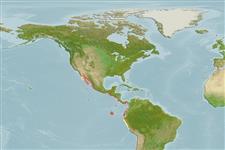Environment: milieu / climate zone / depth range / distribution range
Ecologia
marino demersale; non migratori; distribuzione batimetrica 1 - 50 m (Ref. 89707). Tropical; 32°N - 13°S, 115°W - 76°W (Ref. 5222)
Eastern Pacific: northern Gulf of California to Peru, including the Galapagos Islands.
Size / Peso / Age
Maturity: Lm ? range ? - ? cm
Max length : 30.0 cm TL maschio/sesso non determinato; (Ref. 5222); common length : 18.0 cm TL maschio/sesso non determinato; (Ref. 55763)
Short description
Chiavi di identificazione | Morfologia | Morfometria
Spine dorsali (totale) : 11; Raggi dorsali molli (totale) : 17 - 19; Spine anali: 3; Raggi anali molli: 9. Preopercle rounded, the posterior edge distinctly serrate, with a large spine (usually covered with skin) projecting downward and forward at the angle. Color in life: head and body marbled reddish brown, with obscure bars and small dark and pale spots all over the head, body and median fins. Pectoral fins with 7 or 8 irregular transverse series of small dark spots (Ref. 5222); further characterized by having body depth less than or equal to head length, depth contained 2.3-2.8 times in standard length; caudal peduncle depth 11-12% of SL; eye diameter subequal to snout length, contained 4.1-5.5 times in HL; color in market: similar to color in life but color may fade to a buff, reticulations on pectoral fins usually remain (Ref. 89707).
A shallow water, cryptically colored, secretive species that inhabits seagrass areas. Also found in rocky reefs in depths of 1-50 m (Ref. 89707). Sedentary during the day, hiding in crevices or lying among seaweed, and rely on their effective camouflage to escape detection. Sometimes partly covering itself with sand. Nocturnal predators feeding mainly on benthic crustaceans.
Life cycle and mating behavior
Maturities | Riproduzione | Spawnings | Egg(s) | Fecundities | Larve
Heemstra, P.C. and J.E. Randall, 1993. FAO Species Catalogue. Vol. 16. Groupers of the world (family Serranidae, subfamily Epinephelinae). An annotated and illustrated catalogue of the grouper, rockcod, hind, coral grouper and lyretail species known to date. Rome: FAO. FAO Fish. Synop. 125(16):382 p. (Ref. 5222)
IUCN Red List Status (Ref. 130435)
Threat to humans
Harmless
Human uses
Pesca: di nessun interesse
Strumenti
Special reports
Download XML
Fonti Internet
Estimates based on models
Preferred temperature (Ref.
123201): 20.6 - 28.4, mean 25.9 °C (based on 66 cells).
Phylogenetic diversity index (Ref.
82804): PD
50 = 0.6250 [Uniqueness, from 0.5 = low to 2.0 = high].
Bayesian length-weight: a=0.01148 (0.00558 - 0.02364), b=3.04 (2.88 - 3.20), in cm total length, based on LWR estimates for this (Sub)family-body shape (Ref.
93245).
Trophic level (Ref.
69278): 3.5 ±0.50 se; based on food items.
Resilienza (Ref.
120179): Alto, tempo minimo di raddoppiamento della popolazione meno di 15 mesi (Assuming Fec > 10,000).
Fishing Vulnerability (Ref.
59153): Low vulnerability (20 of 100).
Nutrients (Ref.
124155): Calcium = 163 [65, 301] mg/100g; Iron = 1.07 [0.59, 1.98] mg/100g; Protein = 17.6 [15.8, 19.3] %; Omega3 = 0.244 [0.144, 0.415] g/100g; Selenium = 46.8 [26.8, 90.0] μg/100g; VitaminA = 28.4 [10.4, 87.7] μg/100g; Zinc = 1.26 [0.91, 1.83] mg/100g (wet weight);
